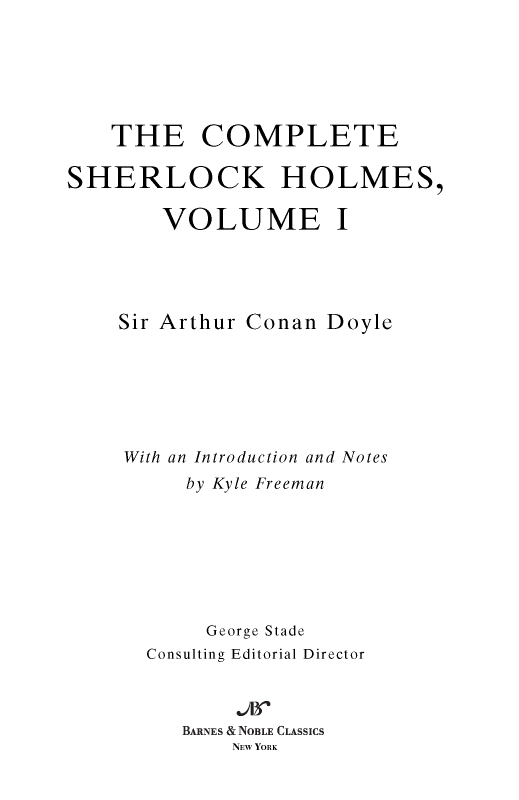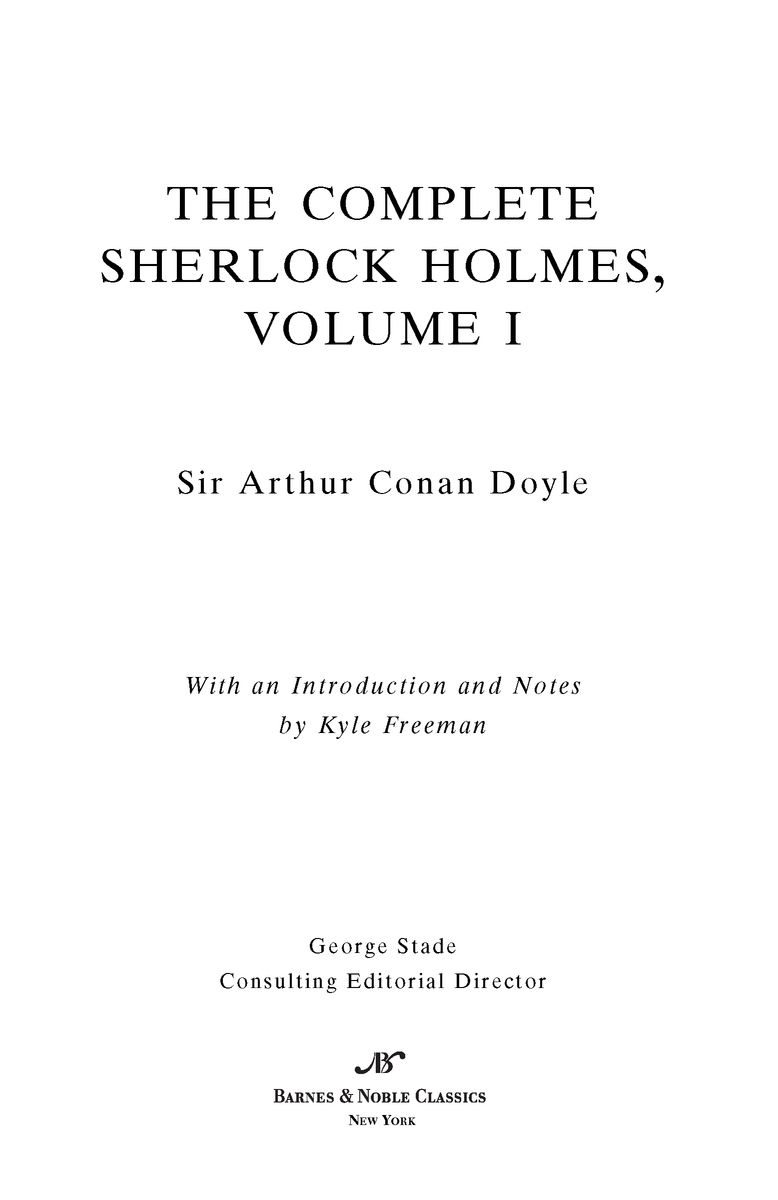The Complete Sherlock Holmes, Volume I (Barnes & Noble Classics Series)
Read The Complete Sherlock Holmes, Volume I (Barnes & Noble Classics Series) Online
Authors: Arthur Conan Doyle

BOOK: The Complete Sherlock Holmes, Volume I (Barnes & Noble Classics Series)
10.49Mb size Format: txt, pdf, ePub

Table of Contents
FROM THE PAGES OF
THE COMPLETE
SHERLOCK HOLMES, VOLUME I
THE COMPLETE
SHERLOCK HOLMES, VOLUME I
“Like all other arts, the Science of Deduction and Analysis is one which can only be acquired by long and patient study, nor is life long enough to allow any mortal to attain the highest possible perfection in it. Before turning to those moral and mental aspects of the matter which present the greatest difficulties, let the inquirer begin by mastering more elementary problems.” (
A Study in Scarlet
, page 17)
A Study in Scarlet
, page 17)
“It is a capital mistake to theorize before you have all the evidence. It biases the judgment.” (
A Study in Scarlet
, page 22)
A Study in Scarlet
, page 22)
“When you have eliminated the impossible, whatever remains,
however improbable
, must be the truth.” (
The Sign of Four
, page 126)
however improbable
, must be the truth.” (
The Sign of Four
, page 126)
“It is the unofficial force—the Baker Street irregulars.”
(
The Sign of Four
, page 145)
The Sign of Four
, page 145)
“Singularity is almost invariably a clue. The more featureless and commonplace a crime is, the more difficult it is to bring it home.”
(“The Boscombe Valley Mystery,” page 240)
He flicked the horse with his whip, and we dashed away through the endless succession of sombre and deserted streets, which widened gradually, until we were flying across a broad balustraded bridge, with the murky river flowing sluggishly beneath us. Beyond lay another dull wilderness of bricks and mortar, its silence broken only by the heavy, regular footfall of the policeman, or the songs and shouts of some belated party of revellers. A dull wrack was drifting slowly across the sky, and a star or two twinkled dimly here and there through the rifts of the clouds. Holmes drove in silence, with his head sunk upon his breast, and the air of a man who is lost in thought. (“The Man with the Twisted Lip,” page 270)
“My name is Sherlock Holmes. It is my business to know what other people don’t know.” (“The Adventure of the Blue Carbuncle,” page 302)
“Crime is common. Logic is rare.”
(“The Adventure of the Copper Beeches,” page 377)
Like all Holmes’s reasoning the thing seemed simplicity itself when it was once explained. (“The Stock-Broker’s Clerk,” page 433)
“Elementary,” said he. (“The Crooked Man,” page 492)
Through the haze I had a vague vision of Holmes in his dressing-gown coiled up in an armchair with his black clay pipe between his lips.
(
The Hound of the Baskervilles
, page 592)
The Hound of the Baskervilles
, page 592)


Published by Barnes & Noble Books
122 Fifth Avenue
New York, NY 10011
122 Fifth Avenue
New York, NY 10011
A Study in Scarlet
was first published in 1887,
The Sign of Four
in 1890, and
The
Hound of the Baskervilles
in 1902. The stories in
Adventures of Sherlock
Holmes
were first collected and published in 1891, and those in
The
Memoirs of Sherlock Holmes
in 1892.
was first published in 1887,
The Sign of Four
in 1890, and
The
Hound of the Baskervilles
in 1902. The stories in
Adventures of Sherlock
Holmes
were first collected and published in 1891, and those in
The
Memoirs of Sherlock Holmes
in 1892.
Published in 2003 by Barnes & Noble Classics with new Introduction,
Notes, Biography, Chronology, A Note on Conveyances, Comments & Questions,
and For Further Reading.
Notes, Biography, Chronology, A Note on Conveyances, Comments & Questions,
and For Further Reading.
General Introduction, Introduction to Volume I, A Note on
Conveyances, Notes, and For Further Reading
Conveyances, Notes, and For Further Reading
Copyright © 2003 by Kyle Freeman.
Note on Sir Arthur Conan Doyle, The World of Sir Arthur Conan Doyle
and
Sherlock Holmes
, and Comments & Questions
Copyright © 2003 by Barnes & Noble, Inc.
and
Sherlock Holmes
, and Comments & Questions
Copyright © 2003 by Barnes & Noble, Inc.
All rights reserved. No part of this publication may be reproduced or
transmitted in any form or by any means, electronic or mechanical, including
photocopy, recording, or any information storage and retrieval system,
without the prior written permission of the publisher.
transmitted in any form or by any means, electronic or mechanical, including
photocopy, recording, or any information storage and retrieval system,
without the prior written permission of the publisher.
Barnes & Noble Classics and the Barnes & Noble Classics
colophon are trademarks of Barnes & Noble, Inc.
colophon are trademarks of Barnes & Noble, Inc.
The Complete Sherlock Holmes, Volume I
ISBN-13: 978-1-59308-034-1 ISBN-10: 1-59308-034-4
eISBN : 978-1-411-43197-3
LC Control Number 2003102759
Produced and published in conjunction with:
Fine Creative Media, Inc.
322 Eighth Avenue
New York, NY 10001
Fine Creative Media, Inc.
322 Eighth Avenue
New York, NY 10001
Michael J. Fine, President and Publisher
Printed in the United States of America
QM
10 12 14 16 18 20 19 17 15 13 11
SIR ARTHUR CONAN DOYLE
Arthur Conan Doyle had many careers—physician, writer of popular fiction and nonfiction, war correspondent, historian, and spiritualist—but it was the creation of his immensely popular Sherlock Holmes that was to be his enduring legacy. The author was born in Edinburgh, Scotland, on May 22, 1859. His mother raised ten children on her husband’s small income; his father’s poor health and heavy drinking made that a daunting task. Despite this adversity, his mother’s willfulness and her exhaustive genealogical research instilled in Arthur a decided sense of purpose.
After early education in Jesuit schools, Conan Doyle enrolled in Edinburgh University, where he earned a medical degree while working part-time to support his family. At the university one of his instructors was Dr. Joseph Bell, who had an uncanny ability to deduce the histories of his patients and who later became a template for Sherlock Holmes. Another teacher, an eccentric Professor Rutherford, inspired the character of Professor George Edward Challenger in
The Lost World
and other novels and short stories.
The Lost World
and other novels and short stories.
Having had a taste of adventure when he served as ship’s physician on a Greenland Sea whaler while still a student, Conan Doyle longed to travel after graduation and so took a position as doctor on a ship en route to West Africa. Returning to England, he set up as a physician in 1882. His practice was small at first, so he had time to do some writing. In 1887 the first Sherlock Holmes story appeared, titled
A Study in Scarlet
. Over the next few years, Conan Doyle would write a historical novel, open a new ocular practice, explore spiritualism, and send Holmes on further thrilling exploits. A second novel,
The Sign of Four
, came out in 1890, and starting in 1891 the Holmes stories regularly appeared in the
Strand Magazine
. Two collections,
The Adventures of Sherlock Holmes
in 1892 and
The Memoirs of Sherlock Holmes
in 1893, collected a total of twenty-four of the mysteries. However, Conan Doyle felt that work on the Holmes stories was keeping him from writing on more serious historical topics. To the shock of his readers, in the 1893 story called “The Final Problem” he described the death of his famous sleuth.
A Study in Scarlet
. Over the next few years, Conan Doyle would write a historical novel, open a new ocular practice, explore spiritualism, and send Holmes on further thrilling exploits. A second novel,
The Sign of Four
, came out in 1890, and starting in 1891 the Holmes stories regularly appeared in the
Strand Magazine
. Two collections,
The Adventures of Sherlock Holmes
in 1892 and
The Memoirs of Sherlock Holmes
in 1893, collected a total of twenty-four of the mysteries. However, Conan Doyle felt that work on the Holmes stories was keeping him from writing on more serious historical topics. To the shock of his readers, in the 1893 story called “The Final Problem” he described the death of his famous sleuth.
Other books
All Bite, No Growl by Jenika Snow
The Laughter of Carthage by Michael Moorcock
Sins of the Fathers by Ruth Rendell
The Amazing Mexican Secret by Jeff Brown
The mountain that went to the sea by Walker, Lucy
Metafísica 4 en 1 Vol.1 by Conny Méndez
Streams of Babel by Carol Plum-Ucci
True Story (The Deverells, Book One) by Jayne Fresina
The Same Sea by Amos Oz
Kingdom of Heroes by Phillips, Jay
